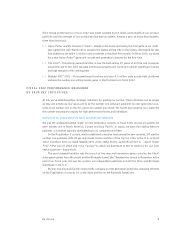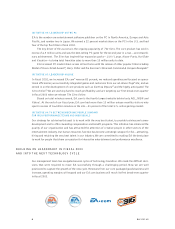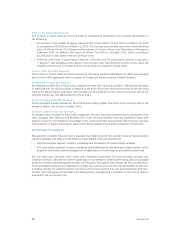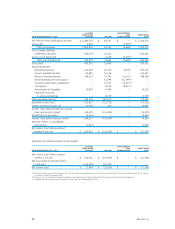Electronic Arts 2002 Annual Report Download - page 18
Download and view the complete annual report
Please find page 18 of the 2002 Electronic Arts annual report below. You can navigate through the pages in the report by either clicking on the pages listed below, or by using the keyword search tool below to find specific information within the annual report.
This Annual Report, including the “Letter to Stockholders” at pages 3 to 7 and the following “Manage-
ment’s Discussion and Analysis of Financial Condition and Results of Operations”, contains forward-looking
statements about circumstances that have not yet occurred. All statements, trend analysis and other
information contained below relating to markets, our products and trends in revenue, as well as other
statements including words such as “anticipate”,“believe” or “expect” and statements in the future tense
are forward-looking statements.These forward-looking statements are subject to business and economic
risks and actual events or our actual future results could differ materially from those set forth in the forward-
looking statements due to such risks and uncertainties.We will not necessarily update information if any
forward-looking statement later turns out to be inaccurate. Risks and uncertainties that may affect our
future results and performance include, but are not limited to, those listed under the heading “Risk Fac-
tors” at page 39 of this Annual Report and discussed under the same heading in our Annual Report on Form
10-K for the year ended March 31, 2002.
CRITICAL ACCOUNTING POLICIES
Management’s Discussion and Analysis of Financial Condition and Results of Operations discusses our con-
solidated financial statements, which have been prepared in accordance with accounting principles generally
accepted in the United States of America.The preparation of these consolidated financial statements
requires management to make estimates and assumptions that affect the reported amounts of assets and
liabilities and the disclosure of contingent assets and liabilities at the date of the consolidated financial
statements and the reported amounts of revenues and expenses during the reporting period.The policies dis-
cussed below are considered by management to be critical because they are both important to the portrayal
of our financial condition and results of operations and their application places the most significant
demands on management’s judgment, with financial reporting results relying on estimates about the effect
of matters that are inherently uncertain. Specific risks for these critical accounting policies are described in
the following paragraphs. For all of these policies, management cautions that actual results may differ
materially from these estimates under different assumptions or conditions.
SALES ALLOWANCES AND BAD DEBT RESERVES
We derive revenues from sales of our packaged goods product, subscriptions of online service, sales of pack-
aged goods through our online store and website advertising. Product revenue is recognized net of an
allowance for returns.We also have stock-balancing programs for our personal computer products that,
under certain circumstances and up to a specified amount, allow for the exchange of personal computer
products by resellers. We may decide to provide price protection under certain circumstances for our per-
sonal computer and video game system products after we analyze: inventory remaining in the channel, the
rate of inventory sell through in the channel, and our remaining inventory on hand.We maintain a policy of
exchanging products or giving credits, but do not give cash refunds.
We estimate potential future product returns, price protection and stock-balancing programs related
to current period product revenue. We analyze historical returns, current sell through of distributor and
retailer inventory of our products, current trends in the video game market and the overall economy, changes
in customer demand and acceptance of our products and other related factors when evaluating the ade-
quacy of the sales returns and price protection allowances. In addition, management monitors and manages
the volume of our sales to retailers and distributors and their inventories as substantial overstocking in the
distribution channel can result in high returns or the requirement for substantial price protection in subsequent
periods. In the past, actual returns have not generally exceeded our reserves. However, actual returns in any
future period are inherently uncertain as unsold products in the distribution channels are exposed to rapid
changes in consumer preferences, market conditions or technological obsolescence due to new platforms,
product updates or competing products. For example, the risk of product returns for our products on mature
platforms may increase as new hardware platforms, such as Xbox, Nintendo GameCube and PlayStation 2,
become more popular.While management believes it can make reliable estimates for these matters, if we
changed our assumptions and estimates, our returns reserves would change, which would impact the net
revenue we report. In addition, if actual returns were significantly greater than the reserves we have estab-
lished, the actual results would decrease our reported revenue. Conversely, if actual returns were
significantly less than our reserves, this would increase our reported revenue.
EA 2002 AR
14
ELECTRONIC ARTS AND SUBSIDIARIES
MANAGEMENT’S DISCUSSION AND ANALYSIS
OF FINANCIAL CONDITION AND RESULTS OF OPERATIONS
























